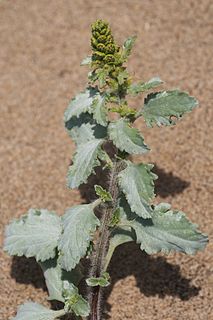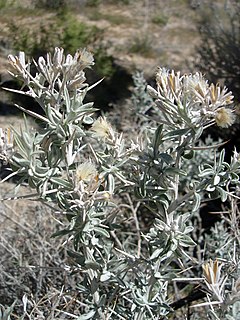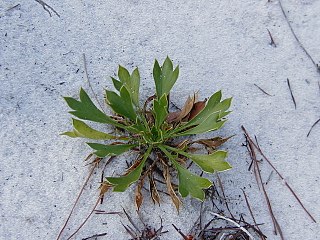
Eryngium is a genus of flowering plants in the family Apiaceae. There are about 250 species. The genus has a cosmopolitan distribution, with the center of diversity in South America. Common names include eryngo and sea holly.

Eryngium alpinum, the alpine sea holly, alpine eryngo or queen of the Alps, is a herbaceous perennial plant in the family Apiaceae.

Eryngium aristulatum, known by the common names California eryngo and Jepson's button celery, is a species of flowering plant in the family Apiaceae.

Eryngium armatum, known by the common names coastal eryngo and prickly coyote thistle, is a species of flowering plant in the family Apiaceae.
Eryngium articulatum is a species of flowering plant in the carrot family known by the common names beethistle and jointed coyote thistle. This plant is native to the northwestern United States from California to Idaho, where it is a plant of marshes and riverbanks. This is a sturdy, branching perennial herb with rounded, naked stems reaching maximum heights over one meter. It has a few sparse sharply serrated leaves at nodes and branching points along its stem. Atop the stem is the rounded to egg-shaped flower head, which looks superficially like that of a thistle, mainly due to its spikiness and lavender color. It is fringed with up to 17 spiny, toothed, pointed bracts, each up to about two centimeters long. Each flower head is packed full of small lavender flowers.
Eryngium castrense is a species of flowering plant in the family Apiaceae known by the common name Great Valley eryngo, or Great Valley button celery. This plant is endemic to California, where it grows in wet areas such as vernal pools and ponds in the central part of the state. This is a heavily branched, spiny perennial herb reaching maximum heights of around half a meter. It produces light green to grayish green hairless stems with occasional lobed, oval-shaped leaves. At the tops of the stems are flower heads one to one and a half centimeters wide and rounded or egg-shaped. At the base of each head is an array of 7 to 9 spiny, pointed bracts up to three centimeters long, and sometimes a few smaller bractlets above. The rounded flower head contains many small white to light purple flowers.
Eryngium constancei is a species of flowering plant in the family Apiaceae known by the common name Loch Lomond button celery, or Loch Lomond coyote thistle. It is endemic to California, where it is known from only three occurrences north of the San Francisco Bay Area. One of the populations is at the Loch Lomond Vernal Pool Ecological Reserve at Loch Lomond in Lake County. The plant appears mainly in vernal pools. It is endangered on the state and federal levels.

Ambrosia chamissonis is a species of ragweed known by the common names silver burr ragweed, silver beachweed and (silver) beach bur(r).

Chaenactis carphoclinia is a species of flowering plant in the daisy family known by the common name pebble pincushion. It is native to the southwestern United States and northwestern Mexico, where it grows in rocky and gravelly habitat, such as the California deserts. The species is found in southern California, Nevada, Utah, Arizona, southwestern New Mexico, Baja California, Sonora.

Cirsium andersonii is a North American species of thistle known by the common names Anderson's thistle and rose thistle. It is native to California, Oregon, and Nevada, where it grows in the woodlands and forest openings of the local high mountain ranges, including the Sierra Nevada and the southern Cascade Range. It has also been reported from Idaho.

Cirsium cymosum is a North American species of thistle known by the common name peregrine thistle. It is native to the western United States, where it has been found in California, Oregon, Nevada, Utah, Idaho, Wyoming, and Montana.
Eryngium pinnatisectum is an uncommon species of flowering plant in the family Apiaceae, known by the common names Tuolumne eryngo and Tuolumne button celery.
Eryngium racemosum is a rare species of flowering plant in the family Apiaceae known by the common name delta eryngo, or delta button celery.
Eryngium spinosepalum, known by the common names spinysepal eryngo and spiny-sepaled button celery, is an uncommon species of flowering plant in the family Apiaceae.
Eryngium vaseyi is a species of flowering plant in the family Apiaceae known by the common name coyotethistle. It is endemic to California, where it is known from vernal pools and similar wet habitat in the Central Valley and certain areas of the Central Coast Ranges and southern California coast. This is a decumbent to upright perennial herb with spreading branches up to half a meter long. The lance-shaped to oblong leaves may be up to 24 centimeters long. The edges are deeply cut into narrow, sharp-pointed lobes. The inflorescence is an array of somewhat rounded flower heads surrounded by several narrow, pointed bracts with spiny edges. The head blooms in whitish petals.

Tetradymia stenolepis is a species of flowering plant in the aster family known by the common name Mojave cottonthorn. It is native to the deserts around the intersection of Arizona, Nevada, and eastern California, where it grows in woodland and scrub habitat on sandy and gravelly substrates. It is a bushy shrub with many branches coated in woolly white fibers and growing to a maximum height just over a meter. The narrow leaves are 2 or 3 centimeters long and harden into straight, sharp spines. Clusters of woolly leaves grow near the spines. The inflorescence bears up to 7 flower heads which are each enveloped in four or five woolly phyllaries. Each head contains up to four or five tubular yellow flowers each around a centimeter long. The fruit is a hairy achene which may be nearly 2 centimeters long, including its pappus of long bristles.

Eryngium pendletonense is a rare species of flowering plant in the carrot family known by the common name Pendleton button-celery. It is endemic to northern San Diego County, California, where it is known from four occurrences along the coastline between Oceanside and the Orange County border, including land within Camp Pendleton. It grows on vernally moist coastal grassland and coastal sage scrub habitat with clay soils. It was first described as a species in 1999.

Eryngium cuneifolium is a rare species of flowering plant in the carrot family known by the common names wedgeleaf eryngo, wedge-leaved button-snakeroot, and simply snakeroot. It is endemic to the state of Florida in the United States where it is known only from Highlands County. It is one of many rare species that can be found only on the Lake Wales Ridge, an area of high endemism. It was federally listed as an endangered species of the United States in 1987.

Eryngium aquaticum is a species of flowering plant in the family Apiaceae known by the common name rattlesnakemaster, marsh rattlesnake master, corn-snakeroot, bitter snakeroot, and marsh eryngo. This plant is native to eastern North America.
Eryngium jaliscense is a plant species native to the Mexican State of Jalisco. It grows in scattered populations in pine forests and other shaded slopes at elevations of 1,200–1,600 m (3,900–5,200 ft).











